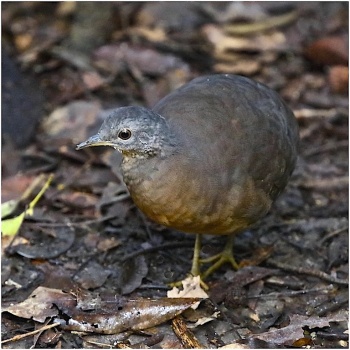- Crypturellus soui
Identification
21·5–24 cm (8½-9½ in)
Plumage variable but recognised by small size and lack of barring.
- Cinnamon to chestnut upperparts
- White throat
- Brownish foreneck becoming cinnamon buff on belly, brighter in female
- Head and rear of neck sooty-brown, darker in female
- Greyish, olive or yellowish legs
Distribution
Central and South America:
Found from southern Mexico south to Panama and in South America in Colombia, Venezuela and the Guianas, Ecuador, Peru, northern Bolivia and much of Amazonian Brazil. Also occurs on Trinidad (the only tinamou) and in east and south-east Brazil.
Taxonomy
Subspecies
There are 14 subspecies[1]:
- C. s. meserythrus: Tropical southern Mexico to Belize, Honduras and south-eastern Nicaragua
- C. s. modestus: Costa Rica and western Panama
- C. s. capnodes: Humid lowlands of north-western Panama
- C. s. poliocephalus: Pacific slope of Panama (Veraguas to Canal Zone)
- C. s. panamensis: Pacific and Caribbean slopes of Panama
- C. s. harterti: Pacific slope of Colombia and Ecuador
- C. s. caucae: Magdalena Valley of north-central Colombia
- C. s. mustelinus: North East Colombia and extreme north-western Venezuela
- C. s. soui: East Colombia to the Guianas and north-eastern Brazil
- C. s. caquetae: South East Colombia (Meta to Caquetá)
- C. s. andrei: Coastal northern Venezuela (Falcón to Monagas); Trinidad
- C. s. nigriceps: Tropical eastern Ecuador and north-eastern Peru
- C. s. inconspicuus: Central and eastern Peru and northern Bolivia
- C. s. albigularis: North and eastern Brazil
panamensis on the Pearl Islands of Panama may be an ancient introduction.
Habitat

Photo © by Luis R
Bosques del Rio Tigre Lodge. Punta Arenas, Costa Rica, 5 March 2020
Rain forest, cloud forest and forest edge.
Behaviour
Shy, secretive and solitary.
Breeding
Breeds May-October, nest is a depression in forest floor, sometimes lined with a few leaves and usually at the base of a tree or bush. Eggs: 2, sometimes 1, reddish to chocolate-brown, very glossy (41 x 32mm). Incubated by male.
Diet
Their varied diet consists of tubers, seeds, fruit and berries. They also eat many insects, including ants and termites.
Vocalisation
Voice: long tremulous whistle heard mainly at dusk.
Movements
A resident species.
References
- Clements, J. F., T. S. Schulenberg, M. J. Iliff, S. M. Billerman, T. A. Fredericks, B. L. Sullivan, and C. L. Wood. 2019. The eBird/Clements Checklist of Birds of the World: v2019. Downloaded from http://www.birds.cornell.edu/clementschecklist/download/
- Handbook of the Birds of the World Alive (retrieved February 2017)
- BF Member observations
Recommended Citation
- BirdForum Opus contributors. (2025) Little Tinamou. In: BirdForum, the forum for wild birds and birding. Retrieved 9 May 2025 from https://www.birdforum.net/opus/Little_Tinamou






